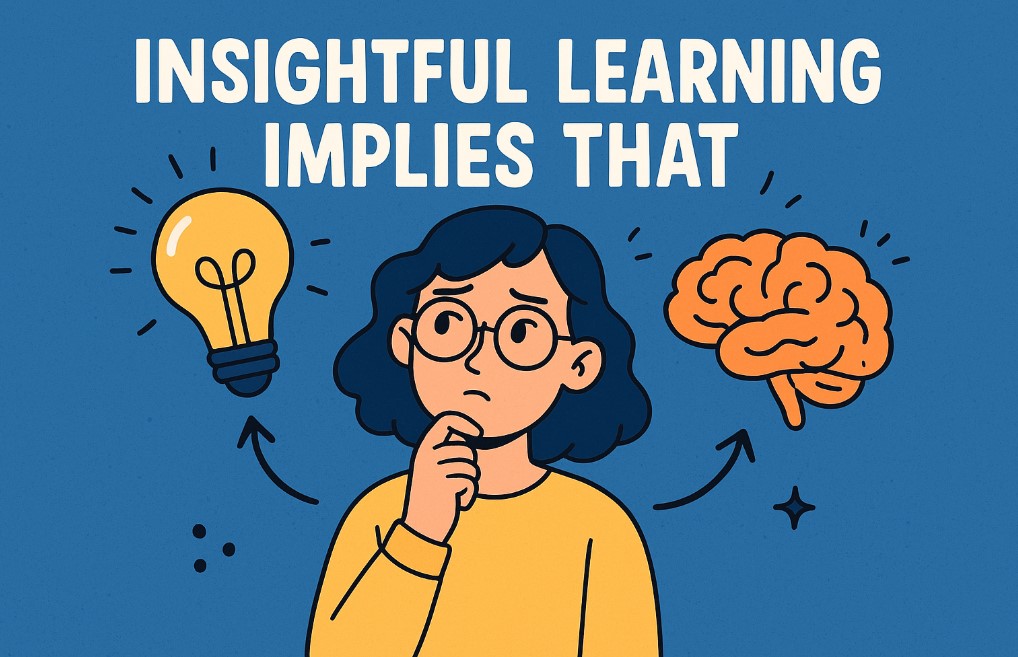In today’s fast-paced world, learning is no longer just about absorbing facts—it’s about understanding them. This is where insightful learning comes into play. Unlike traditional methods that rely on repetition or rote memorization, insightful learning implies that true education happens when individuals connect ideas, recognize patterns, and apply knowledge creatively. This article explores what insightful learning means, why it matters, and how it can transform education, workplaces, and personal growth.
What Is Insightful Learning?
Insightful learning implies that learning is a dynamic process driven by “aha moments.” Coined by psychologist Wolfgang Köhler in the early 20th century, the concept emerged from experiments with chimpanzees. Köhler observed that when faced with a problem (e.g., reaching bananas placed out of reach), the animals didn’t just try random actions. Instead, they paused, assessed the situation, and suddenly used tools (like stacking boxes) to solve the problem. This “lightbulb moment” exemplifies insightful learning: the ability to grasp solutions through internal cognitive restructuring rather than trial and error.
In humans, insightful learning implies that we don’t just memorize formulas or facts. Instead, we understand the underlying principles, allowing us to adapt knowledge to new scenarios. For example, a student who grasps why math equations work—not just how to solve them—can tackle unfamiliar problems more effectively.
Read More: Insightful
How Insightful Learning Differs from Other Learning Styles
To appreciate why insightful learning implies that deeper understanding is critical, let’s compare it to other methods:
-
Rote Learning: Focuses on memorization without context. While useful for basics like multiplication tables, it falls short in fostering problem-solving skills.
-
Observational Learning: Involves mimicking others (e.g., apprenticeships). Though practical, it may not encourage independent critical thinking.
-
Insightful Learning: Prioritizes comprehension and adaptability. It implies that learners “see the bigger picture,” enabling them to innovate rather than replicate.
For instance, a chef using rote learning might follow recipes exactly, while one practicing insightful learning understands flavor combinations, allowing them to create original dishes.
Why Insightful Learning Matters in Modern Education
Traditional education systems often emphasize standardized testing, which rewards memorization over creativity. However, insightful learning implies that education should prepare students for real-world challenges where solutions aren’t pre-defined. Here’s why it’s essential:
-
Encourages Critical Thinking: Students learn to question assumptions and analyze information.
-
Builds Adaptability: Understanding concepts deeply helps individuals pivot when faced with new problems.
-
Fosters Innovation: Breakthroughs in science, art, and technology often arise from insightful connections (e.g., Newton’s apple leading to gravitational theory).
Schools adopting this approach use project-based learning, open-ended questions, and interdisciplinary studies to nurture these skills.
Insightful Learning in the Workplace
The corporate world is catching on too. Insightful learning implies that employees who understand their roles holistically contribute more meaningfully. For example:
-
A marketer who grasps consumer psychology can design campaigns that resonate emotionally.
-
Engineers who master core principles can troubleshoot unexpected technical issues.
Companies like Google and 3M encourage “20% time”—allowing employees to explore passion projects. This autonomy often leads to innovative ideas (e.g., Gmail’s creation) by fostering insightful problem-solving.
How to Foster Insightful Learning
Whether you’re a teacher, manager, or self-learner, here’s how to cultivate insightful learning:
-
Encourage Curiosity: Ask “why” and “how” questions to dig deeper into topics.
-
Embrace Challenges: Present problems without immediate solutions to stimulate critical thinking.
-
Promote Interdisciplinary Connections: Link concepts across subjects (e.g., how history influences literature).
-
Allow Time for Reflection: Insights often emerge during quiet moments, not rushed study sessions.
-
Use Real-World Applications: Case studies and simulations help learners apply knowledge practically.
3 Short FAQs About Insightful Learning
Q1: What does insightful learning imply about traditional teaching methods?
A: Insightful learning implies that methods focused solely on memorization limit students’ ability to adapt. It advocates for teaching strategies that prioritize understanding, creativity, and real-world application.
Q2: Can insightful learning be applied in workplaces?
A: Absolutely. By encouraging employees to understand workflows deeply and think critically, organizations foster innovation. Techniques like cross-training and hackathons align with insightful learning principles.
Q3: How can parents support insightful learning at home?
A: Encourage exploration over rote answers. Ask open-ended questions (e.g., “Why do you think the sky is blue?”) and provide resources for hands-on experiments or creative projects.
The Future of Learning Is Insightful
As automation and AI handle repetitive tasks, human skills like creativity and adaptability become invaluable. Insightful learning implies that the future belongs to those who can think beyond textbooks—connecting ideas, solving novel problems, and driving progress. By embracing this approach, educators, employers, and individuals can unlock untapped potential and thrive in an ever-evolving world.
From classrooms to boardrooms, the shift toward insightful learning isn’t just a trend—it’s a necessity. After all, true mastery isn’t about knowing all the answers; it’s about asking the right questions.
Read More: lessinvest.com crypto
